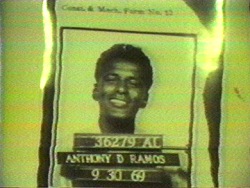Anthony Ramos
Biography
Anthony Ramos was among the earliest artists to use video as a tool for mass media critiques and cultural documentation, and to examine media presentations of "truth." In his powerful video works of the 1970s, Ramos combined art and activism, giving visibility to the experiences of marginalized groups, including Black Americans and those incarcerated for protesting the Vietnam War. In his earliest black-and-white video pieces, Ramos engaged in forceful, direct performances for the camera, often using physical endurance and actions to confront political issues.
Ramos produced a number of video works that critique the media through deconstruction and appropriation, and explore the relation of mass culture and the politics of race in the United States. Ramos's 1977 video, About Media, is an incisive deconstruction of television news. It documents an interview Ramos gave to news reporter Gabe Pressman on the subject of Ramos's eighteen-month prison term for draft resistance during the Vietnam War. Ramos appropriates the interview, contrasting the unedited interview footage with the final televised news report and exposing the artifice of television news. He also interjects footage of his extraordinary and unnerving early performances, including Balloon Nose Blow-Up (1972), which speak to the influence of Allan Kaprow, with whom Ramos had studied and worked in California.
Ramos has traveled widely in Europe, Africa, China and the Middle East. He videotaped the end of Portugal's colonial rule of Cape Verde and Guinea-Bissau, Tehran during the 1980 hostage crisis, and Beijing just prior to the Tiananmen Square massacre. In the late 1980s he turned to painting as his primary medium.
Ramos was born in 1944 in Providence, Rhode Island. He received an M.F.A. from the California Institute of the Arts. Among his awards are a National Endowment for the Arts Visual Arts Fellowship and a Rockefeller Foundation Fellowship. In the 1970s, Ramos was a video consultant for the United Nations and the National Council of Churches. In the 1980s, he lived in Paris, where he was a Professor at the American Center, and oversaw the television cabling of ten blocks of Paris for the first time. He has also taught at Rhode Island School of Design, New York University, and the University of California at San Diego.
His work has been featured in numerous exhibitions worldwide, including Paris Noir: Artistic circulations and anti-colonial struggles (1950-2000), Centre Pompidou, Paris (2025); The Embodied Vision: Performance for the Camera, Museu Nacional de Arte Contemporânea do Chiado, Lisbon (2014); Circa 1971: Early Video & Film from the EAI Archive, Dia: Beacon, New York (2011–12); the Whitney Biennial (1975 and 1979); Art Vidéo-Confrontation, Musée d'art moderne de la Ville de Paris (1974); Art now 74, Kennedy Center, Washington, D.C. (1974); and Circuit: A Video Invitational, Everson Museum of Art, Syracuse, New York (1973). His videos have been screened at L'Alliance New York, Electronic Arts Intermix, Film Society of Lincoln Center, Centre Pompidou, and Light Industry.
Ramos lives in Eyguieres, France.
